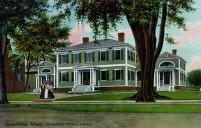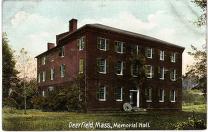|

"The Country Builder's Assistant, Fully Explaining The Best Methods For Striking Regular And Quirked Mouldings:"

Greenfield Public Library

"Deerfield, Mass., Memorial Hall."
|
Summary and Objective
Students will discover the golden ratio using Fibonacci numbers. Students will understand that the golden ratio was used in architecture. Students will discover the golden ratio was used in buildings designed by Asher Benjamin, local architect.
Teaching Plan
Step 1.
Ask students to list the next three numbers in the following pattern: 1,1,2,3,5,8,13,21,34,55,..,..,..
The next three numbers are 89,144,and 233. You get these numbers by adding the previous two terms together,i.e. 5 + 8 =13. This is a famous pattern-the Fibonacci numbers-and this pattern is found in nature and architecture to list two examples.(see web link below for information on Fibonacci numbers in nature.)
Step 2.
Explore more about this pattern. Find the ratio for each set of two terms. Examples: 1/1 = 1, 2/1 = 2,3/2 = 1.5, 5/3 = 1.6666, 8/5 = 1.6, 13/8 = 1.625, 21/13 = 1.615, etc. Continue for all numbers you used for the pattern. Students should see that as we get away from the beginning numbers, the ratio is always about 1.6 or 1.62. This ratio is called the golden ratio. People think that rectangles that are most pleasing to the eye have sides that are in this ratio.
Step 3.
(Optional step) Ask your students to draw a rectangle. Have them measure the longest side in centimeters,being as exact as possible with their measurements. Now divide this number by the golden ratio (1.6 or 1.62). Have students measure the other side of their rectangle. Is this side close to the number they just calculated? If yes, then their rectangle is a golden rectangle with sides in proportions of the golden ratio.
Step 4.
The Parthenon in Greek architecture is a famous example of a building that uses golden rectangles and the golden ratio. Note: if your building uses the CMP math program there is a good illustration of this in the seventh grade book "Stretching and Shrinking". It is on page 74 of the new edition of this book.(see web link below for a picture of the parthenon.)
Step 5.
We will investigate some buildings designed in the 1790s by the local architect, Asher Benjamin. Many of his buildings are examples of the Greek Revival style of architecture. (see web link below for information about the Greek Revival style of architecture.)
Step 6.
Make copies of the following for students:Country Builder's Assistant-pages 112, 129, and 132; Greenfield Public Library, and Memorial Hall. Hint: to print go to the Look Closer section and zoom in closer. Right click on the image to print or follow instructions at the bottom of the page on printing help.
Step 7.
Measure the long side of the main part of the buildings. (Measure using centimeters.)Divide this measurement by the golden ratio and check to see if the other dimension of the rectangle is about this number. (It should be) Hint: When measuring the doorway, measure to the very top of the structure.
Step 8.
(Optional step) Assign students to look for examples of Greek Revival architecture in your local community-they could take a photo of any building that they suspect uses the golden ratio and then bring the photos into class to test
|




